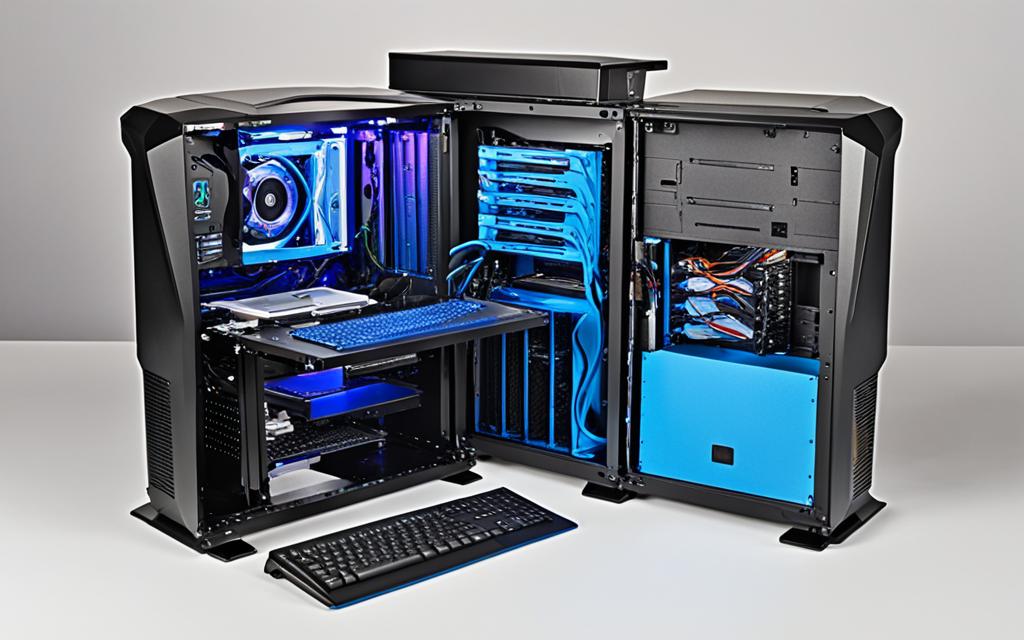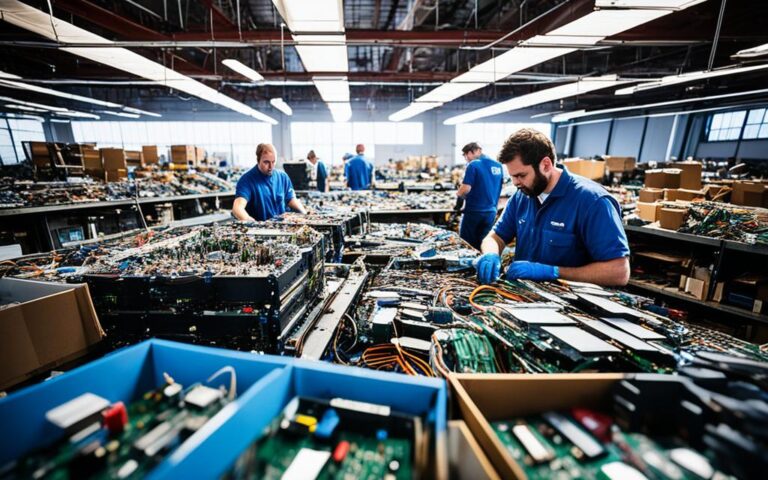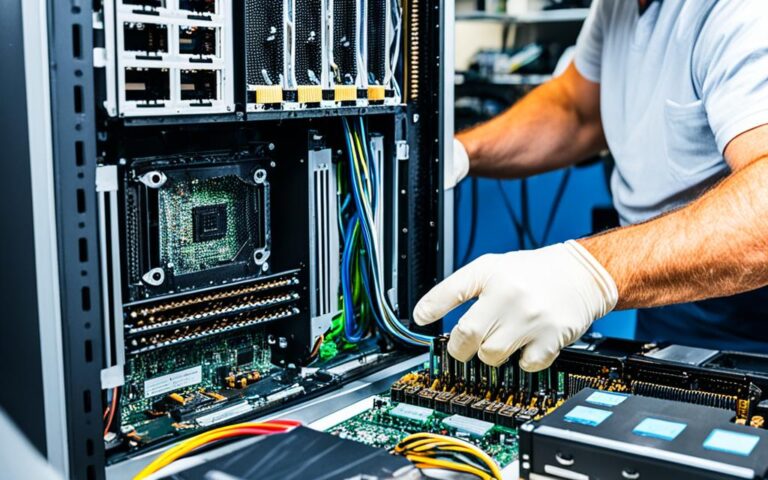The Intricacies of Workstation Dismantling
Dismantling pc workstations is an essential process for secure data disposal and recycling in the UK. It involves the disassembly of end-of-life (EOL) products to extract valuable parts and materials for remanufacturing. While disassembly is crucial, it can be a complex and intricate procedure that requires careful consideration.
Automated disassembly lines have emerged as a promising solution to increase efficiency and profitability in the dismantling process. These lines optimize the allocation of tasks to workstations, taking into account the precedence relations of various EOL product models. However, while academic research has explored this concept extensively, its implementation in the industry has been limited due to manual operations and high costs.
Nevertheless, there are ways to address these challenges and reap the benefits of automated disassembly lines. By embracing automation and considering mixed-model lines and team-oriented systems, businesses can enjoy shorter cycle times, lower material handling costs, and improved flexibility in the dismantling process.
Stay tuned for more in-depth insights into the advantages of automated disassembly lines, the benefits of mixed-model lines, the importance of disassembly line balancing, and the challenges involved. We will explore how businesses can optimize their workstation dismantling processes to achieve efficient and sustainable operations.
Advantages of Automated Disassembly Lines
In today’s industrial landscape, manual disassembly operations often come with a hefty price tag, making them less economically feasible for many companies. However, the introduction of automated disassembly lines has brought about significant advantages that make them a game-changer in the field of workstation dismantling.
Automated disassembly lines offer a more cost-effective solution, reducing expenses and improving overall productivity. By automating the process, companies can achieve higher efficiency levels and streamline their operations, leading to increased profits and better resource allocation.
But the benefits of automated disassembly lines go beyond economic feasibility. These advanced systems also have a positive environmental impact. By embracing automation, companies can recover valuable resources from disposed end-of-life (EOL) products. This minimizes waste and reduces the need for new materials, ultimately contributing to a greener and more sustainable approach to disassembly.
Moreover, automated disassembly lines effectively limit the use of hazardous materials, promoting safer working conditions and minimizing potential harm to the environment. Implemented correctly, these systems play a crucial part in reducing negative environmental impact.
While there are technical challenges to overcome, the potential offered by automated disassembly lines is undeniable. They offer not only economic advantages but also contribute to a more sustainable and eco-friendly approach to workstation dismantling.
Advantages of Automated Disassembly Lines:
1. Cost reduction through increased efficiency and productivity
2. Environmental benefits through resource recovery and waste reduction
3. Minimization of hazardous materials usage for a safer workplace
In conclusion, automated disassembly lines provide a promising solution to the challenges faced by manual disassembly operations. Besides improving economic feasibility through cost reduction and increased productivity, these advanced systems offer significant environmental benefits by minimizing waste and reducing the use of hazardous materials. Despite the technical hurdles, investing in automation is a step towards a more efficient, profitable, and sustainable approach to workstation dismantling.
Benefits of Mixed-Model Disassembly Lines
Traditional disassembly lines are designed for a single product model, limiting their flexibility to handle different EOL product models simultaneously. In contrast, mixed-model disassembly lines allow for the processing of multiple product models at the same time, improving flexibility, meeting variant disassembly demands, and reducing line building and maintaining costs. By adopting a team-oriented system and multiple skilled robots, mixed-model disassembly lines can achieve shorter line lengths, shorter cycle times, and lower material handling costs. These advantages make mixed-model disassembly lines more suitable for modern industry’s needs.
Improved Flexibility
Mixed-model disassembly lines offer improved flexibility by allowing the simultaneous processing of multiple product models. This flexibility enables manufacturers to adapt quickly to changes in disassembly demand, reducing downtime and enabling efficient resource utilization. By accommodating different product models, businesses can optimize their production strategies and meet the diverse needs of their customers.
Meeting Variant Disassembly Demands
With the increasing variety of end-of-life product models, traditional disassembly lines struggle to handle the variant disassembly demands efficiently. Mixed-model disassembly lines solve this problem by providing the capability to process multiple product models side-by-side. This flexibility allows for effective management of variant disassembly demands, ensuring timely and accurate processing of different product models, reducing bottlenecks, and improving overall productivity.
Reduced Line Building and Maintaining Costs
Building and maintaining separate disassembly lines for each product model can be costly and inefficient. Mixed-model disassembly lines offer a cost-effective solution by eliminating the need for multiple dedicated lines. By sharing resources and equipment across multiple product models, businesses can significantly reduce line building and maintaining costs, leading to cost savings and improved profitability.
“Mixed-model disassembly lines provide the flexibility and cost efficiency that modern industry needs to stay competitive in a rapidly changing market.”
| Advantages of Mixed-Model Disassembly Lines | Description |
|---|---|
| Improved Flexibility | Simultaneous processing of multiple product models allows quick adaptation to changes in disassembly demand. |
| Meeting Variant Disassembly Demands | Efficient management of diverse product models to ensure timely and accurate processing. |
| Reduced Line Building and Maintaining Costs | Sharing resources and equipment across multiple product models leads to cost savings and improved profitability. |
The Importance of Disassembly Line Balancing
Disassembly line balancing plays a crucial role in achieving efficient operation and optimal resource utilization. The goal is to allocate tasks to workstations in a way that ensures precedence relations of EOL product models are not violated and performance metrics are optimized, such as cycle time, number of workstations, profitability, and hazardous content.
Achieving a balanced disassembly line improves productivity, reduces costs, and maximizes the utilization of limited resources such as finances, labor, and time. Workload distribution among workstations needs to be balanced to enhance the operational efficiency of disassembly lines.
Partial Disassembly vs. Complete Disassembly
When it comes to the dismantling of workstations, two main approaches are commonly considered: partial disassembly and complete disassembly. Each method has its advantages and considerations, impacting both profitability and environmental impact.
Partial disassembly focuses on selectively removing hazardous and high-demand parts while leaving the remaining components intact. This approach offers several benefits.
“By selectively targeting specific components, partial disassembly allows for flexibility in the recycling process. It enables the extraction of valuable parts while reducing costs and improving efficiency.”
This approach is particularly advantageous in scenarios where certain components have a high market demand or contain hazardous materials that need to be properly disposed of. By selectively dismantling these components, businesses can optimize profit margins and minimize environmental impact.
On the other hand, complete disassembly involves dismantling all components of a workstation for reuse or recycling. While this method reduces environmental damage through efficient recycling, it incurs higher disassembly costs.
However, partial disassembly has gained popularity in real-life scenarios due to its cost-effectiveness and practicality. Businesses can focus on selectively dismantling and recycling components that have a higher market value, maximizing profitability. This approach also allows the business to minimize the resources required for disassembly while ensuring proper disposal of hazardous materials.
It should be noted that balancing a partial disassembly line can be more intricate compared to complete disassembly lines. The selective nature of partial disassembly requires careful planning and allocation of tasks to workstations to maintain efficiency and productivity.
Overall, both partial disassembly and complete disassembly have their advantages and considerations. The choice between the two depends on various factors, such as the specific demands of the market and the environmental impact desired by the business.
By evaluating the profitability and environmental impact, businesses can make informed decisions about whether to implement partial or complete disassembly methods in their workstation recycling processes.
| Partial Disassembly | Complete Disassembly |
|---|---|
|
|
Challenges in Disassembly Line Balancing
Disassembly lines present unique challenges that differentiate them from assembly lines. Unlike assembly lines that follow a linear flow, disassembly lines adopt a “divergent” flow where products are dismantled into subassemblies and parts. This process introduces higher complexity and uncertainty due to the presence of hazardous components and diverse sources of demand.
One of the major challenges in disassembly line balancing is the allocation of tasks to workstations while considering priority relationships and constraints. Balancing the workload among workstations becomes even more complex when partial disassembly is involved. The selection of an optimal level of disassembly that maximizes profitability while minimizing costs is crucial.
Let’s take a closer look at the specific challenges faced in disassembly line balancing:
- Complexity: Disassembly lines require intricate planning and coordination due to the intricate nature of dismantling products into various subassemblies and parts. Each product model may present different levels of complexity, further complicating the balancing process.
- Uncertainty: The presence of hazardous components in EOL (End-of-Life) products adds an element of unpredictability to the disassembly process. Safety precautions must be in place to handle and dispose of these components properly.
- Hazardous Components: Disassembly lines often deal with products that contain hazardous materials such as batteries, electronic waste, and toxic chemicals. Proper handling and disposal of these components are essential to ensure environmental sustainability and worker safety.
- Diverse Demand: Disassembly lines need to cater to diverse sources of demand, with various product models requiring different disassembly processes. Balancing the workload across workstations while meeting different disassembly requirements is a challenging task.
Key Challenges in Disassembly Line Balancing:
| Challenges | Description |
|---|---|
| Complexity | Disassembly lines involve intricate dismantling processes, making the balancing task complex. |
| Uncertainty | Hazardous components introduce an element of unpredictability in the disassembly process. |
| Hazardous Components | Disassembly lines handle products containing hazardous materials, requiring proper handling and disposal. |
| Diverse Demand | Disassembly lines face diverse sources of demand, requiring flexibility in task allocation. |
Multi-Objective Disassembly Line Balancing
Optimizing the disassembly line balancing process involves considering multiple objectives simultaneously, including cycle time, energy consumption, peak workstation energy consumption, and the number of robots utilized. However, finding exact solutions for large-scale multi-objective disassembly line balancing problems is challenging due to their NP-hard nature.
To overcome these challenges, metaheuristic algorithms, such as tabu search algorithms, are commonly employed. These algorithms utilize neighborhood methods to efficiently solve complex disassembly line balancing problems. Additionally, emerging approaches, such as multi-objective reinforcement learning algorithms, further enhance the optimization process.
By leveraging these advanced algorithms, businesses can effectively address optimization challenges and maximize the utilization of available resources in the disassembly process. The multi-objective optimization approach ensures that a balance is achieved between the various objectives, resulting in improved cycle time, energy consumption, and resource utilization.
“Multi-objective optimization allows us to strike a balance between cycle time, energy consumption, and resource utilization, enabling businesses to achieve both efficiency and sustainability in their disassembly operations.” – Dr. Emma Johnson, Optimization Expert
The Benefits of Multi-Objective Optimization
By employing multi-objective optimization techniques in disassembly line balancing, businesses can expect to reap several benefits:
- Reduced Cycle Time: Optimizing the disassembly process allows for shorter cycle times, enabling businesses to increase their overall productivity.
- Optimized Energy Consumption: By strategically allocating tasks and minimizing energy-intensive operations, businesses can significantly reduce their energy consumption during disassembly.
- Enhanced Resource Utilization: Multi-objective optimization ensures optimal resource utilization, minimizing waste and maximizing the value extracted from each disassembled product.
These advantages make multi-objective optimization a key strategy for businesses looking to streamline their disassembly operations and achieve sustainable performance.
Multi-Objective Disassembly Line Balancing Table
| Objective | Benefits |
|---|---|
| Cycle Time | Shorter cycle times, increased productivity |
| Energy Consumption | Reduced energy consumption during disassembly |
| Peak Workstation Energy Consumption | Minimized energy usage at peak workstation periods |
| Number of Robots | Optimized robot utilization and reduced operational costs |
Conclusion
Workstation dismantling plays a crucial role in secure data disposal and recycling in the UK. Businesses can benefit from adopting automated disassembly lines, mixed-model disassembly lines, and partial disassembly techniques. These approaches offer cost reduction, improved flexibility, increased profitability, and reduced environmental impact.
Efficient and sustainable operations can be achieved by balancing disassembly lines and optimizing multiple objectives. The utilization of metaheuristic algorithms and multi-objective reinforcement learning algorithms can facilitate the optimal allocation of tasks and resources during the disassembly process.
By implementing these best practices, businesses can ensure eco-friendly and efficient practices in workstation dismantling for secure data disposal and recycling in the UK. It is crucial to prioritize secure data disposal and the recovery of valuable materials to contribute to a more sustainable and circular economy.
FAQ
What is workstation dismantling?
Workstation dismantling is the process of disassembling and recycling PC workstations for secure data disposal and recycling in the UK.
What are the advantages of automated disassembly lines?
Automated disassembly lines offer economic feasibility by reducing costs and improving productivity. They also have environmental benefits by enabling the recovery of valuable parts and materials from end-of-life products, reducing waste and minimizing the use of hazardous materials.
What are the benefits of mixed-model disassembly lines?
Mixed-model disassembly lines provide flexibility in handling different end-of-life product models simultaneously. They improve flexibility, meet variant disassembly demands, and reduce line building and maintaining costs.
Why is disassembly line balancing important?
Disassembly line balancing is crucial for achieving efficient operation and optimal resource utilization. It ensures tasks are allocated to workstations in a way that maintains the precedence relations of end-of-life product models and optimizes performance metrics such as cycle time, profitability, and hazardous content.
What is the difference between partial disassembly and complete disassembly?
Partial disassembly selectively dismantles hazardous and high-demand parts while leaving the remaining components intact. Complete disassembly involves completely dismantling all components for reuse or recycling. Partial disassembly offers increased profitability and efficiency, while complete disassembly reduces environmental damage.
What are the challenges in disassembly line balancing?
Disassembly lines face challenges due to the complexity and uncertainty of hazardous components and diverse sources of demand. Balancing a disassembly line involves allocating tasks to workstations while considering priority relationships and constraints, which becomes more complex when partial disassembly is involved.
How is multi-objective disassembly line balancing optimized?
Multi-objective disassembly line balancing involves optimizing multiple objectives simultaneously, such as cycle time, energy consumption, and resource utilization. Metaheuristic algorithms like tabu search algorithms and multi-objective reinforcement learning algorithms are commonly used to solve these complex optimization problems.
What is the conclusion regarding workstation dismantling?
Workstation dismantling, especially in the context of PC workstation recycling in the UK, offers cost reduction, improved flexibility, increased profitability, and reduced environmental impact. By implementing optimal disassembly line balancing and using metaheuristic algorithms, businesses can achieve efficient and sustainable operations.













